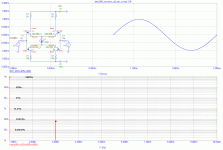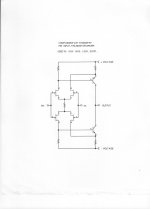Marce, what do you have to say about the rumors that you are deceased?
Highly exaggerated ;-)
Marce, what do you have to say about the rumors that you are deceased?
Nope, I think they are untrue, just been going through a rough paths the last 12 months, especially the last few months. Slowly bouncing back. Or maybe I'm just a ghost in the machine.😀
I hope we can again find some topic that is related to linear audio electronic design, as this thread was founded upon. I realize that some who continue here do not believe that improvement is necessary, or that IC's can do the majority of the tasks, just like mid-fi designers do, but I beg to differ. Discrete tube or solid state design is superior, overall, than virtually any IC to my knowledge today, for the best recording or playback in my opinion and experience, and many could benefit from learning how to do it better.
John, you like records, right? Can you fix your broken one? If you want to talk improved discrete, why not throw some ideas out?
OK Kids, let's make a first class preamp, power amp, whatever!
First, you have to get Idss matched complementary jfets. I know that they are rare and expensive, but they are necessary. If you can't bother, then we are doomed from the start. What about it guys?
First, you have to get Idss matched complementary jfets. I know that they are rare and expensive, but they are necessary. If you can't bother, then we are doomed from the start. What about it guys?
First, you have to get Idss matched complementary jfets.
A serious question albeit perhaps "trivial", why symmetric stuff, the lowest harmonic coming out of symmetric is H3 (well, some H2 due to non-existing perfect complementary parts), while SE and alikes fundamental harmonic is always starting at the lower H2.
First, you have to get Idss matched complementary jfets. I know that they are rare and expensive, but they are necessary. If you can't bother, then we are doomed from the start. What about it guys?
First - what's the specification for this project?
You need to decide that before you can even think about what parts are needed.
Or for small signals use modern components, minimise signal paths, control everything with a considered layout, local isolated power islands, same with digital to analogue, especially on the digital side. I would have thought low noise pre-amplification could be done by IC's these days, they seem to crop up in circuits quite often for that purpose...🙂
OK Kids, let's make a first class preamp, power amp, whatever!
First, you have to get Idss matched complementary jfets. I know that they are rare and expensive, but they are necessary. If you can't bother, then we are doomed from the start. What about it guys?
First point of contention -- why is that actually valuable? JFETs fine, plenty of merits there, but fully complementary is plenty contentious without much in terms of benefit for discrete. What's the justification?
How about a much more accessible first-class arrangement and starting with just n-jfets? The selection (shrinking rapidly) is infinitely better. Not like we cannot boost the input rails up high to get the common mode range we'd want.
OK Kids, let's make a first class preamp, power amp, whatever!
First, you have to get Idss matched complementary jfets. I know that they are rare and expensive, but they are necessary. If you can't bother, then we are doomed from the start. What about it guys?
Blah blah blah.
Now that the 'peanut gallery' has made their criticisms, I will go forward with MY VERSION of high quality audio electronic design.
First, I will have to describe the input stage that I tend to use, its advantages, trade-offs, etc. Now, this is not really a new input stage design, I have used it for the last 45 years, and finally it is now appearing in engineering textbooks, but it does have some advantages.
Now, I will have to search for visual aids to give further insight.
First, I will have to describe the input stage that I tend to use, its advantages, trade-offs, etc. Now, this is not really a new input stage design, I have used it for the last 45 years, and finally it is now appearing in engineering textbooks, but it does have some advantages.
Now, I will have to search for visual aids to give further insight.
Don't forget to inform whom of the chinaBay vendors is you trusted jfet supplier so the happy diya community can realize it.
Here is my first practical implementation of this input stage to make a working line stage. It became a working module for the Grateful Dead 'Wall of Sound' electronics in 1963 and for the line stage of the Levinson JC-2 preamp at about the same time. This design works fairly well, is very fast, about 100V/us, and sounds subjectively very good. Better circuits can be made however.
Attachments
Distorsion a little to high - should be below 0,003% in order to be inaudible acc to Mr Benchmark. But then you need to allow for other units to take part in the budget so why not aim for 0,001%. At the same time - please develop a measurement procedure that mimic music dynamics and richness - sine is so boring.
//
//
- Status
- Not open for further replies.
- Home
- Member Areas
- The Lounge
- John Curl's Blowtorch preamplifier part II

